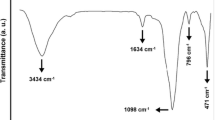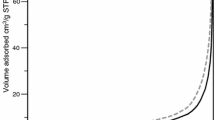Abstract
Tailor-made poly(methyl methacrylate)/mesoporous diatomite nanocomposites were synthesized by in situ simultaneous reverse and normal initiation technique for atom transfer radical polymerization (SR&NI ATRP). Inherent characteristics of diatomite platelets were evaluated by using FTIR spectroscopy and nitrogen adsorption/desorption isotherm. Moreover, evaluation of pore size distribution and morphological studies were also performed by scanning and transmission electron microscopy. Conversion and molecular mass determinations were carried out using gas and size exclusion chromatography, respectively. Addition of 3 wt% pristine mesoporous diatomite leads to increase in conversion from 76 to 90%. Molecular mass of poly(methyl methacrylate) chains increases from 16,484 to 19,472 g mol−1 by addition of 3 wt% pristine mesoporous diatomite; however, polydispersity index values increase from 1.18 to 1.48. Appropriate agreement between theoretical and experimental molecular mass in combination with low PDI values can appropriately demonstrate the living nature of the polymerization. Increasing thermal stability of the nanocomposites is demonstrated by TGA. Differential scanning calorimetry shows an increase in glass transition temperature from 80.6 to 85.9 °C by adding 3 wt% of mesoporous diatomite platelets.










Similar content being viewed by others
References
Du H, Xu GQ, Chin WS. Synthesis, characterization, and nonlinear optical properties of hybridized CdS-polystyrene nanocomposites. Chem Mater. 2002;14:4473–9.
Dolati S, Fereidoon A, Sabet AR. The effect of nanoclay on damaged areas of composite and nanocomposite laminates. Int J Nanosci Nanotechnol. 2013;9:25–32.
Janowska G, Mikołajczyk T, Olejnik M. Thermal properties and flammability of fibres made from polyimidoamide nanocomposite. J Therm Anal Calorim. 2007;88:843–9.
Kodge A, Kalyane S, Lagashetty A. Synthesis, characterization and thermal study of poly (methyl methacrylate)-Co3O4 nanocomposite film. Int J Nano Dimens. 2012;3:53–7.
Pourasghar A, Kamarian S. Mechanical material characterization of an embedded Carbon nanotube in polymer matrix by employing an equivalent fiber. Int J Nano Dimens. 2015;6:167–75.
Ghobadi E, Hemmati M, Khanbabaei G, Shojaei M, Asghari M. Effect of nanozeolite 13X on thermal and mechanical properties of Polyurethane nanocomposite thin films. Int J Nano Dimens. 2015;6:177–81.
Tayebi H, Bigdeli A, Torabinezhad A, Tayebi S. Polypropylene/Polystyrene in situ nano reinforced blends fiber: Morphology and properties. Int J Nano Dimens. 2015;6:305–14.
Khezri K, Ghasemi M, Fazli Y. Effect of mesoporous diatomite particles on the kinetics of SR&NI ATRP of styrene and butyl acrylate. Z Phys Chem. 2018. https://doi.org/10.1515/zpch-2017-1063.
Al-Degs YS, Tutunju MF, Shawabkeh RA. The feasibility of using diatomite and Mn—diatomite for remediation of Pb2+, Cu2+, and Cd2+ from water. Sep Sci Technol. 2000;35:2299–310.
Jeong S, Jeon J, Lee J, Kim S. Optimal preparation of PCM/diatomite composites for enhancing thermal properties. Int J Heat Mass Transf. 2013;62:711–7.
Jian Z, Qingwei P, Meihong N, Haiqiang S, Na L. Kinetics and equilibrium studies from the methylene blue adsorption on diatomite treated with sodium hydroxide. Appl Clay Sci. 2013;83–84:12–6.
Yuan P, Liu D, Tan D, Liu K, Yu H, Zhong Y, Yuan A, Yu W, He H. Surface silylation of mesoporous/macroporous diatomite (diatomaceous earth) and its function in Cu(II) adsorption: the effects of heating pretreatment. Microporous Mesoporous Mater. 2013;170:9–19.
Nenadovic S, Nenadovic M, Kovacevic R, Matovic LJ, Matovic B, Jovanovic Z, Grbovic Novakovic J. Influence of diatomite microstructure on its adsorption capacity for Pb(II). Sci Sinter. 2009;41:309–17.
Jia Y, Han W, Xiong G, Yang W. Diatomite as high performance and environmental friendly catalysts for phenol hydroxylation with H2O2. Sci Technol Adv Mater. 2007;8:106–9.
Tsai W, Lai C, Hsien K. Characterization and adsorption properties of diatomaceous earth modified by hydrofluoric acid etching. J Colloid Interface Sci. 2006;297:749–54.
Caliskan N, Kul AR, Alkan S, Sogut EG, Alacabey I. Adsorption of Zinc(II) on diatomite and manganese-oxide-modified diatomite: a kinetic and equilibrium study. J Hazard Mater. 2011;193:27–36.
Abbasian M, Khakpour Aali N. Nitroxide-mediated radical polymerization of styrene initiated from the surface of titanium oxide nanoparticles. J Nanostruct. 2016;6:38–45.
Sarsabili M, Kalantari K, Khezri K. SR&NI atom transfer radical random copolymerization of styrene and butyl acrylate in the presence of MPS-functionalized silica aerogel nanoparticles. J Therm Anal Calorim. 2016;126:1261–72.
Abbasian M, Jaymand M, Ghadami MZ, Fathi A. Preparation of reactive and thermal stable hyperbranched graft copolymers/clay nanocomposite via ‘Living’ free radical polymerization. Int J Nanosci Nanotechnol. 2010;6:168–78.
Min K, Matyjaszewski K, Matyjaszewski K. Atom transfer radical polymerization in aqueous dispersed media. Cent Eur J Chem. 2009;7:657–74.
Karaman S, Karaipekli A, Sarı A, Bicer A. Polyethylene glycol (PEG)/diatomite composite as a novel form-stable phase change material for thermal energy storage. Solar Energy Mater Solar Cells. 2011;95:1647–53.
Li X, Bian C, Chen W, He J, Wang Z, Xu N, Xue G. Polyaniline on surface modification of diatomite: a novel way to obtain conducting diatomite fillers. Appl Surf Sci. 2003;207:378–83.
Li X, Li X, Wang G. Fibrillar polyaniline/diatomite composite synthesized by one-step in situ polymerization method. Appl Surf Sci. 2005;249:266–70.
Hu S, Zhu X, Hu W, Yan L, Cai C. Crystallization behaviors and foaming properties of diatomite-filled polypropylene composites. Polym Bull. 2013;70:517–33.
Liang JZ. Effects of extrusion conditions on die-swell behavior of polypropylene/diatomite composite melts. Polym Test. 2008;27:936–40.
Khezri K, Fazli Y. Characterization of diatomite platelets and its application for in situ atom transfer radical random copolymerization of styrene and butyl acrylate: normal approach. J Inorg Organomet Polym. 2017;27:266–74.
Yu Y, Addai-Mensah J, Losic D. Functionalized diatom silica microparticles for removal of mercury ions. Sci Technol Adv Mater. 2012;13:015008 (11 pp).
Garderen N, Clemens FJ, Mezzomo M, Bergmann CP, Graule T. Investigation of clay content and sintering temperature on attrition resistance of highly porous diatomite based material. Appl Clay Sci. 2011;52:115–21.
Du Y, Yan J, Meng Q, Wang J, Dai H. Fabrication and excellent conductive performance of antimony-doped tin oxide-coated diatomite with porous structure. Mater Chem Phys. 2012;133:907–12.
Liu D, Yuan P, Tan D, Liu H, Wang T, Fan M, Zhu J, He H. Facile preparation of hierarchically porous carbon using diatomite as both template and catalyst and methylene blue adsorption of carbon products. J Colloid Interface Sci. 2012;388:176–84.
Li M, Jahed NM, Min K, Matyjaszewski K. Preparation of Linear and Star-Shaped Block Copolymers by ATRP Using Simultaneous Reverse and Normal Initiation Process in Bulk and Miniemulsion. Macromolecules 2004;37:2434–41.
Davoudizadeh S, Sarsabili M, Khezri K. Synthesis and Characterization of polystyrene/mesoporous diatomite composites via activators generated by electron transfer for atom transfer radical polymerization. Z Phys Chem. 2017;231:1543–58.
Fazli Y, Khezri K. Well-defined PMMA/diatomite nanocomposites by in situ AGET ATRP: diatomite as an appropriate replacement for clay. J Polym Res. 2018;25:9–19.
Khezri K. Polystyrene–mesoporous diatomite composites produced by in situ activators regenerated by electron transfer atom transfer radical polymerization. RSC Adv. 2016;6:109286–95.
Fazli Y, Khezri K. Mesoporous diatomite-filled PMMA by in situ reverse atom transfer radical polymerization. Colloid Polym Sci. 2017;295:247–57.
Khezri K, Fazli Y. Polystyrene/mesoporous diatomite composites by in situ simultaneous reverse and normal initiation technique for atom transfer radical polymerization. Polym Sci Ser B. 2017;59:109–16.
Ver Meer MA, Narasimhan B, Shanks BH, Mallapragada SK. Effect of mesoporosity on thermal and mechanical properties of polystyrene/silica composites. ACS Appl Mater Interfaces. 2010;2:41–7.
Sarsabili M, Rahmatolahzadeh R, Shobeiri SA, Hamadanian M, Farazin A, Khezri K. Reverse atom transfer radical random copolymerization of styrene and methyl methacrylate in the presence of diatomite nanoplatelets. Polym Adv Technol. 2018;29:424–32.
Author information
Authors and Affiliations
Corresponding author
Rights and permissions
About this article
Cite this article
Khezri, K., Alijani, H. & Fazli, Y. Preparation of PMMA/mesoporous diatomite nanocomposites by in situ SR&NI ATRP. J Therm Anal Calorim 132, 937–945 (2018). https://doi.org/10.1007/s10973-018-7011-7
Received:
Accepted:
Published:
Issue Date:
DOI: https://doi.org/10.1007/s10973-018-7011-7




